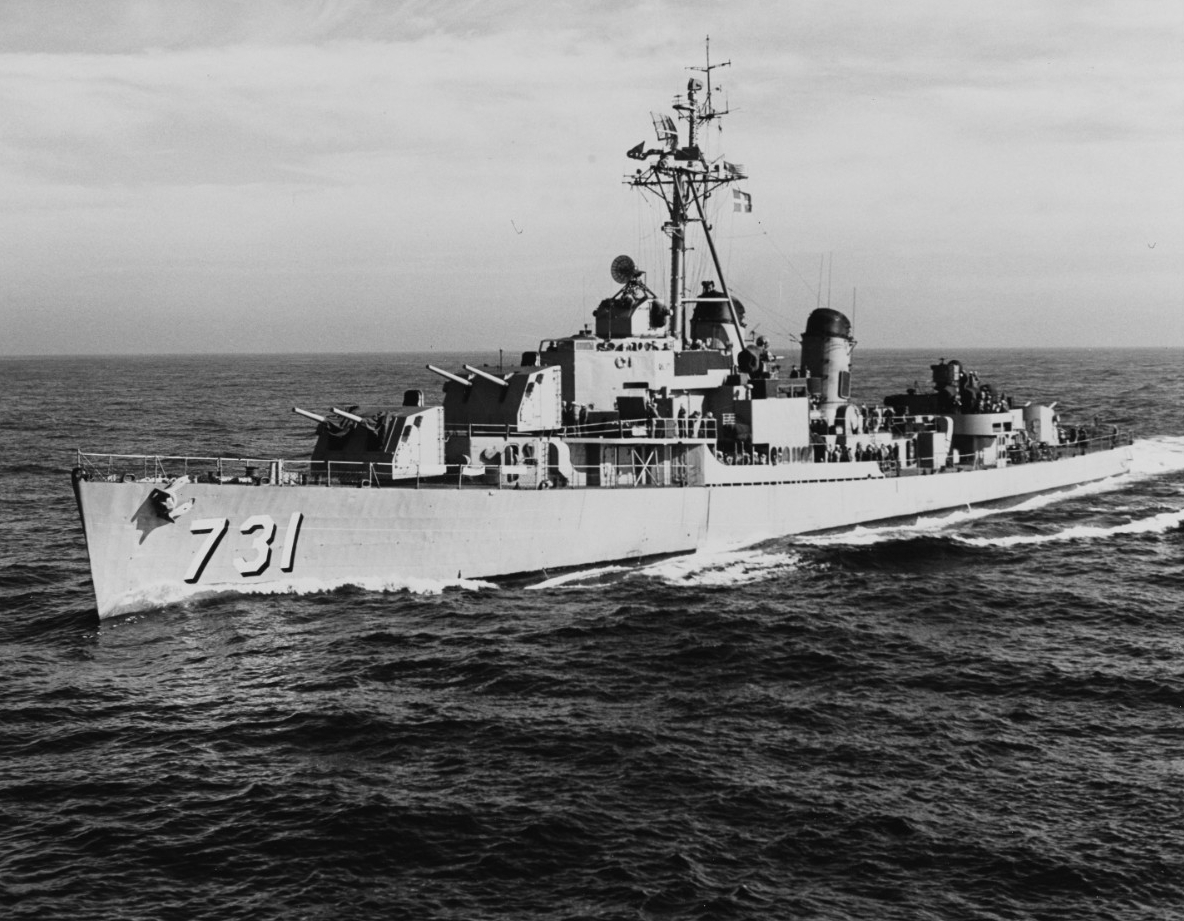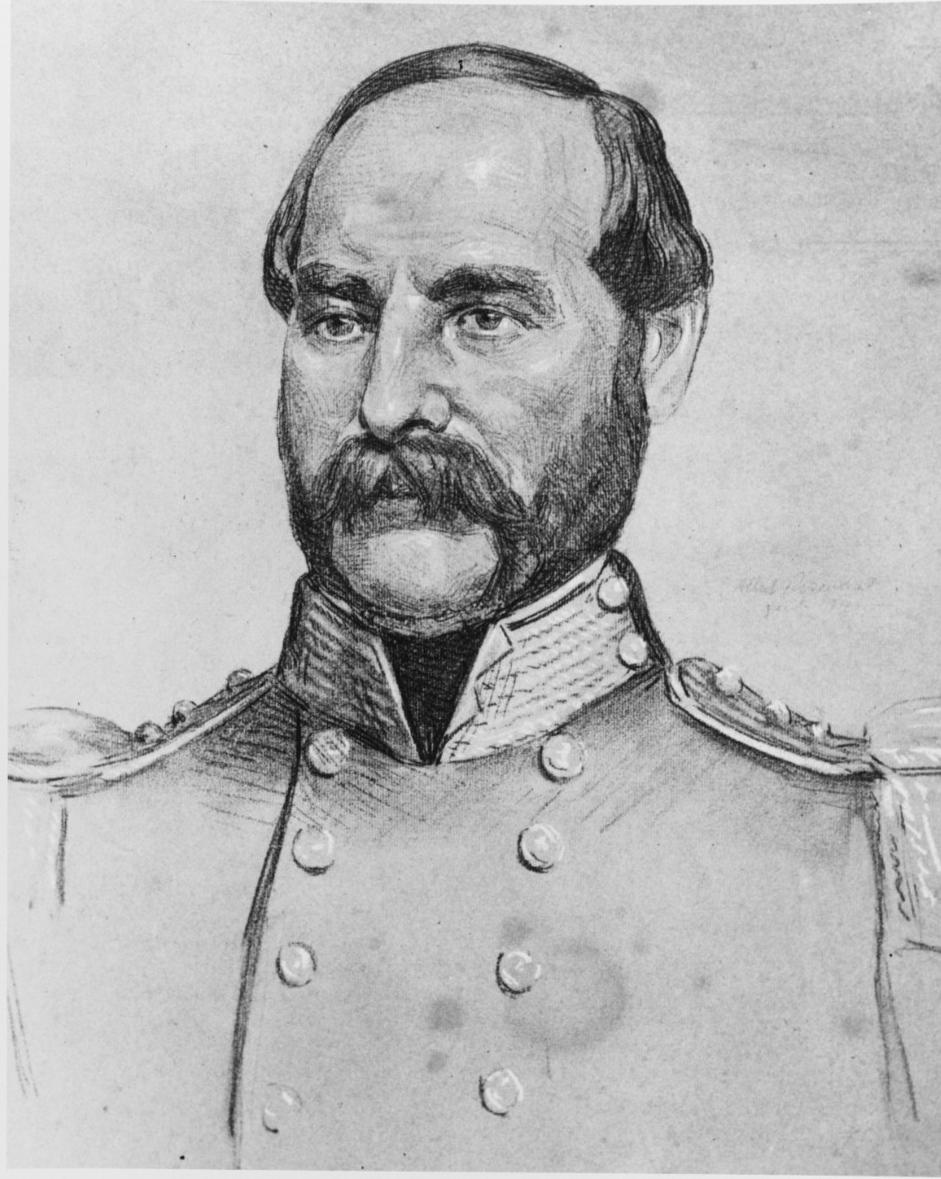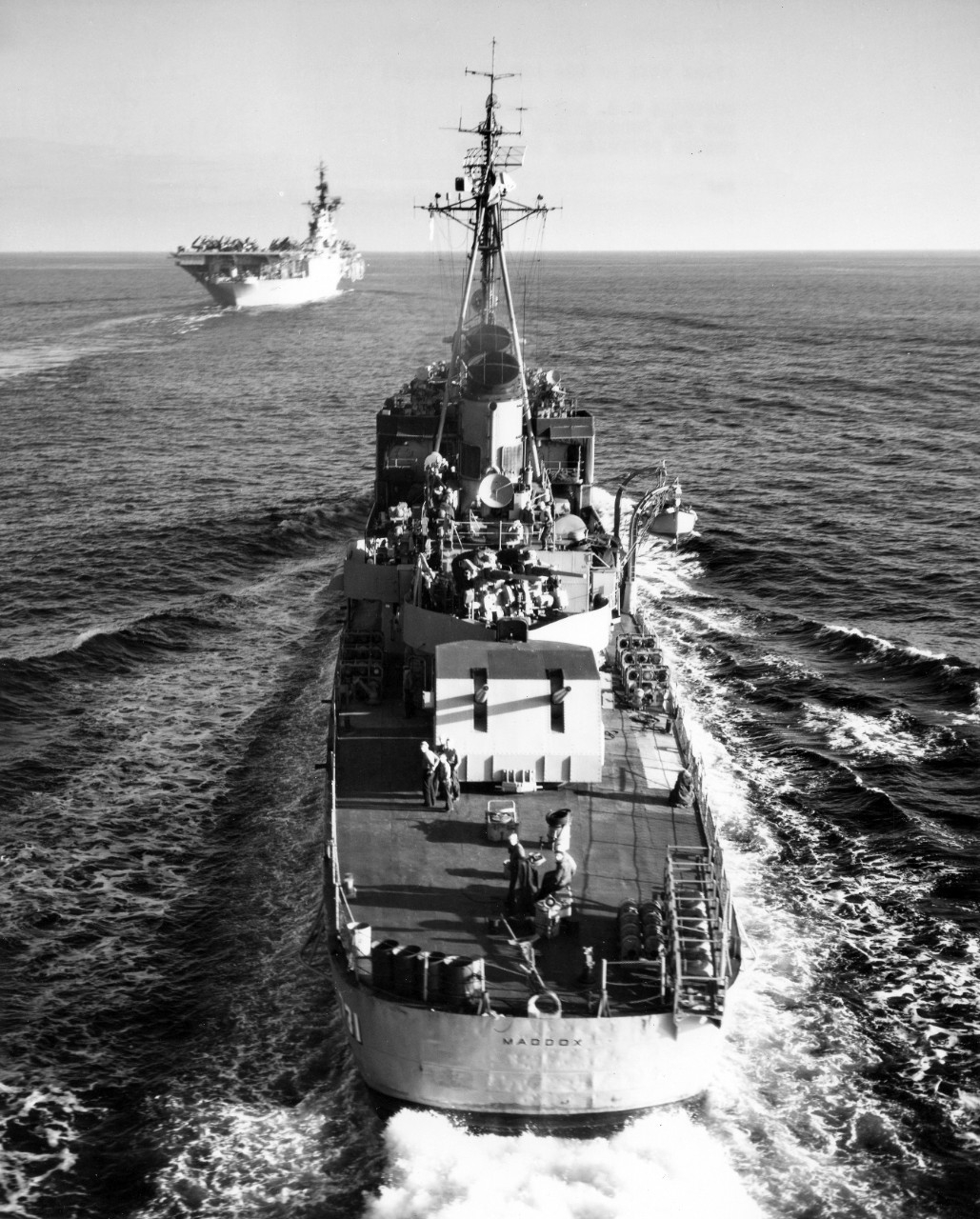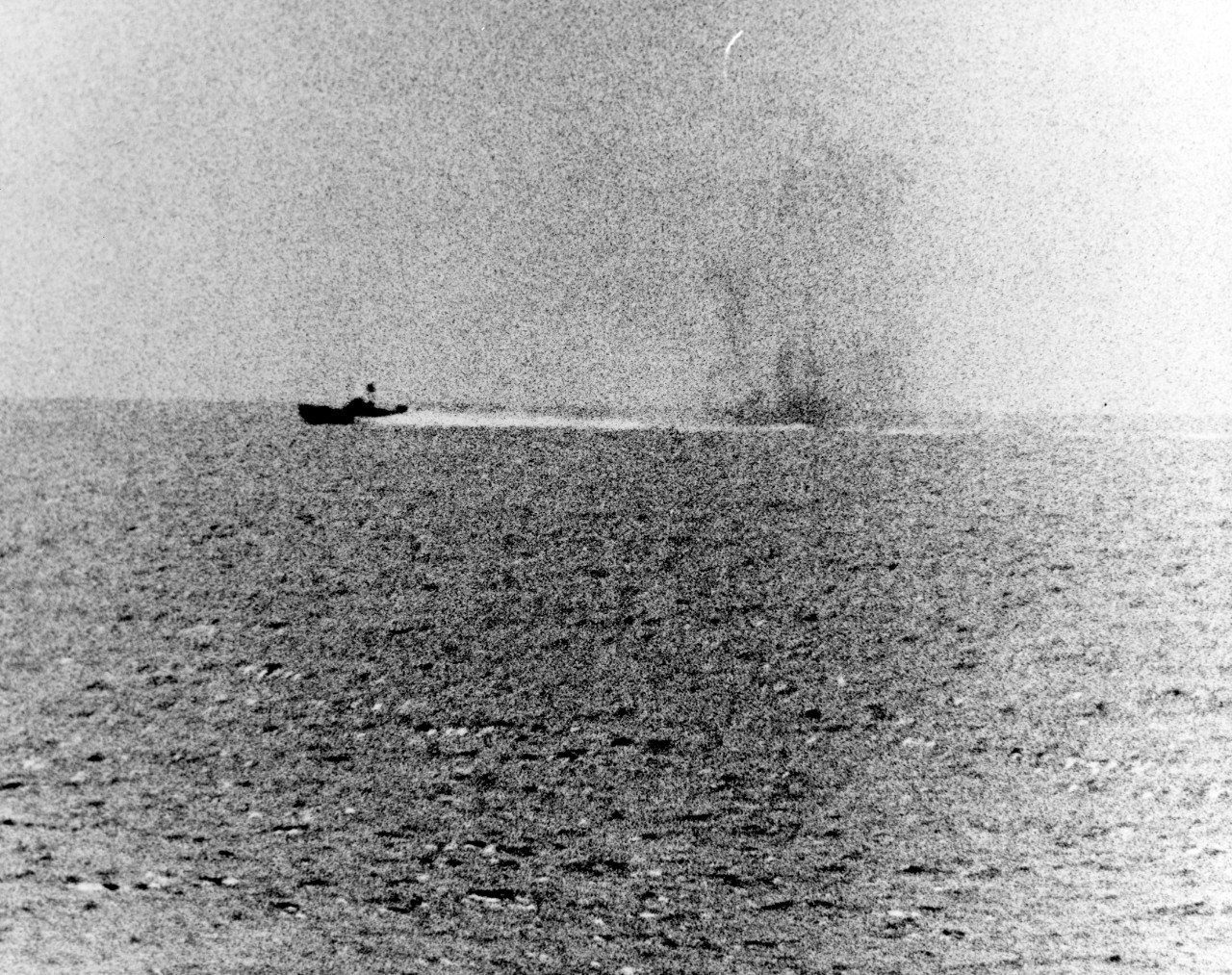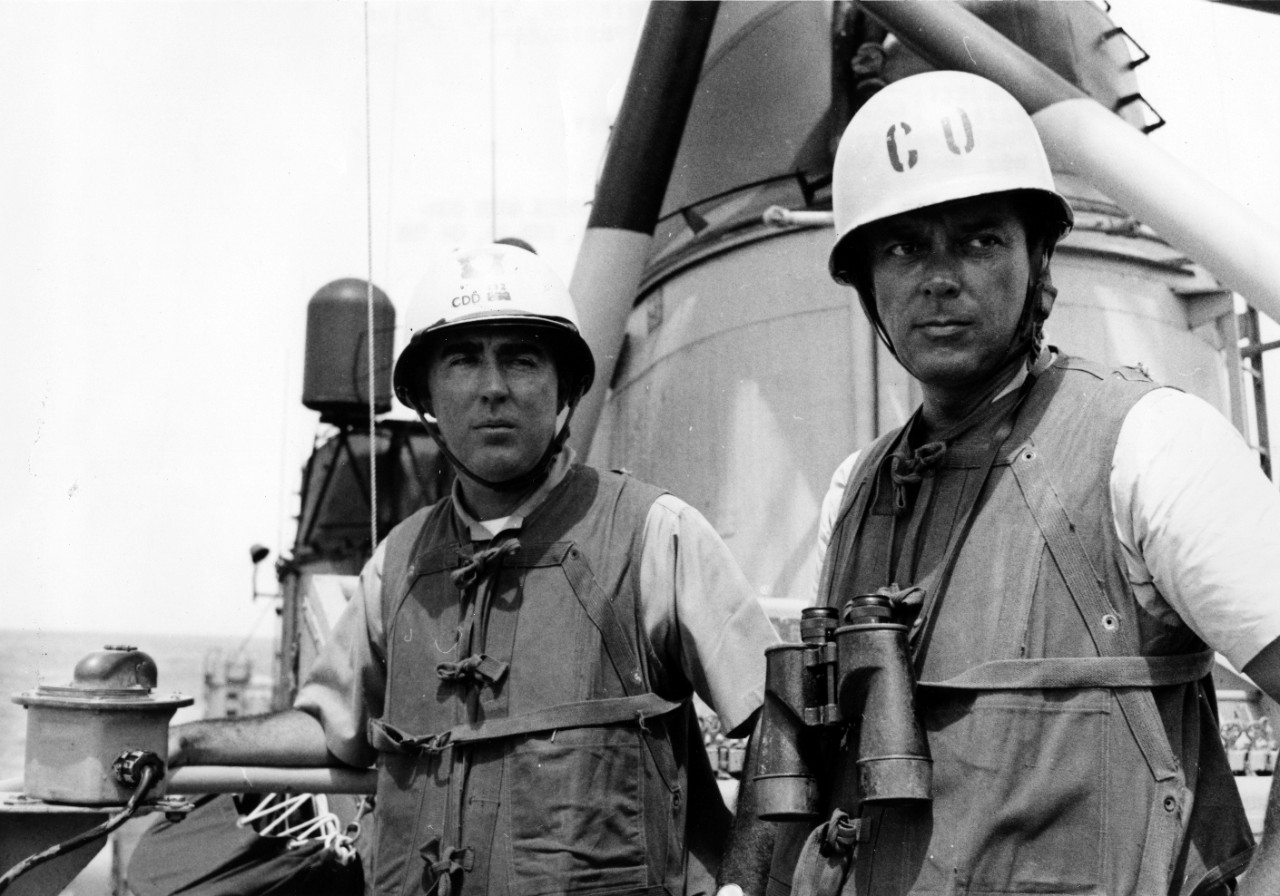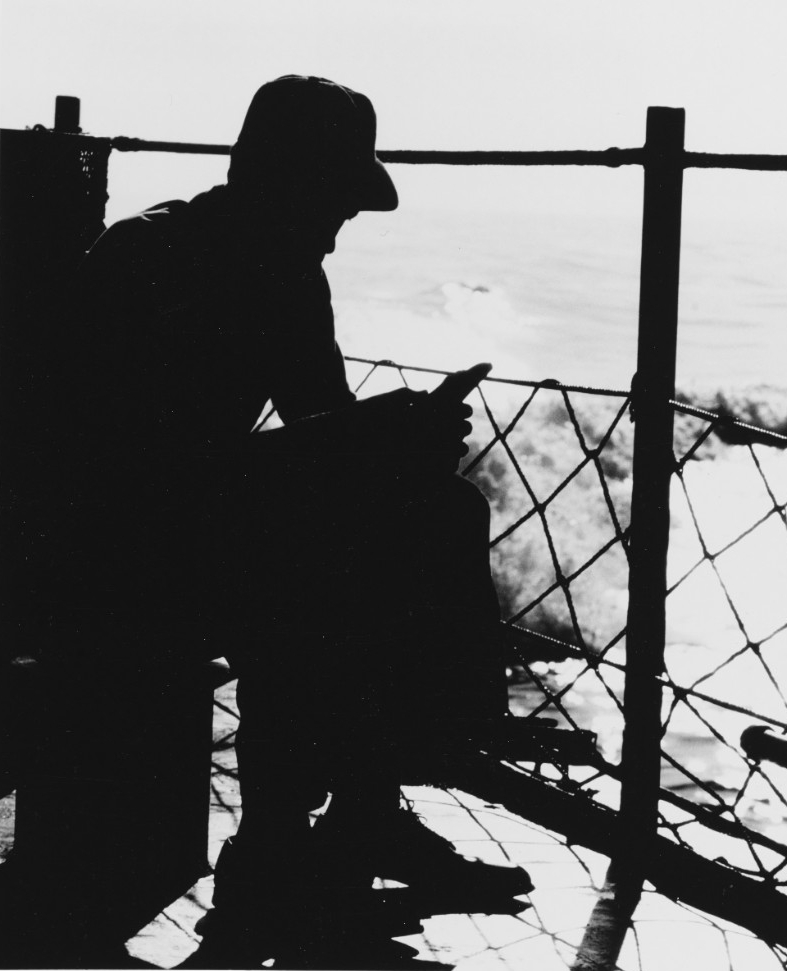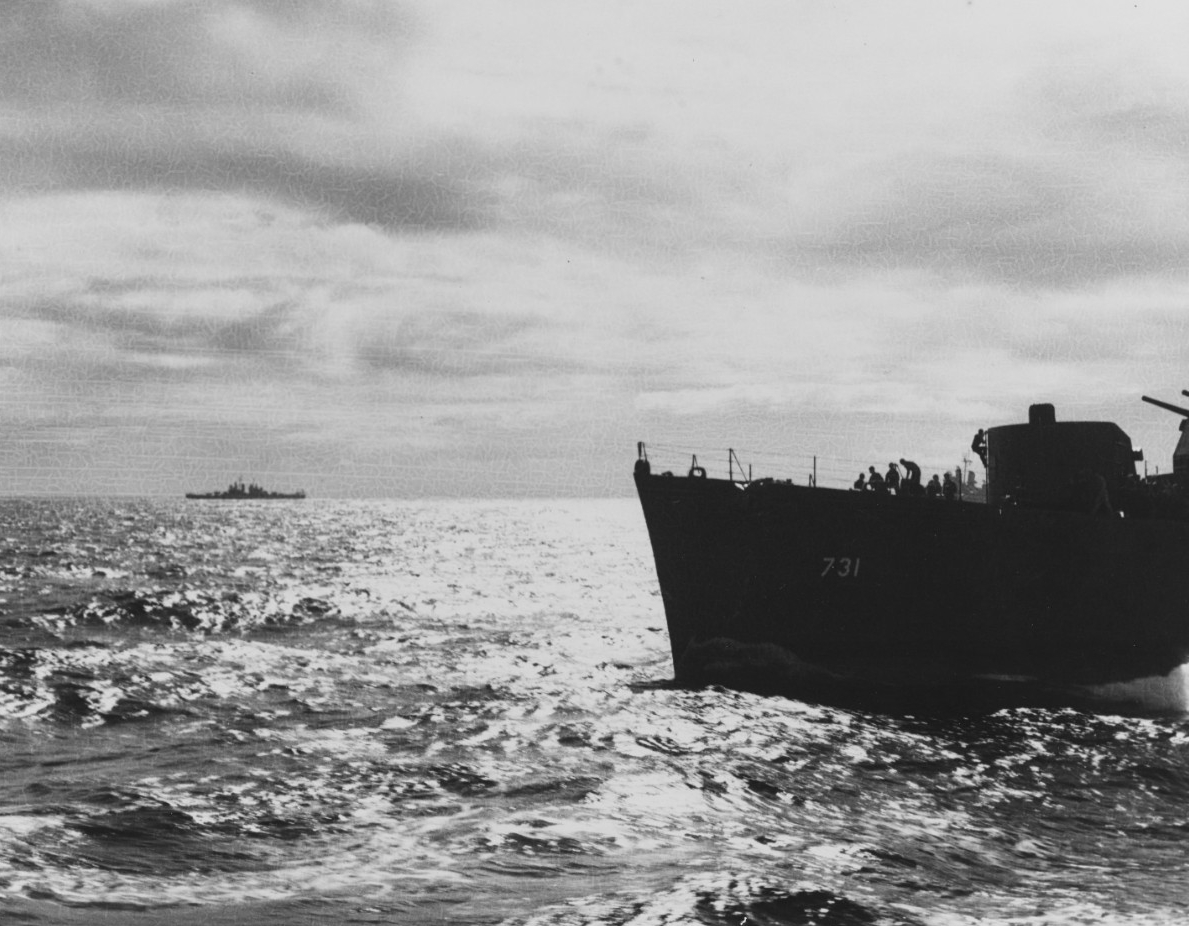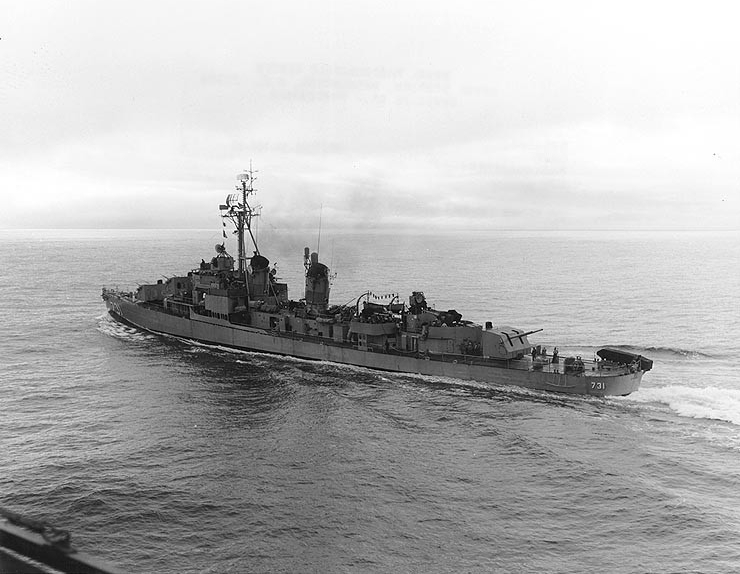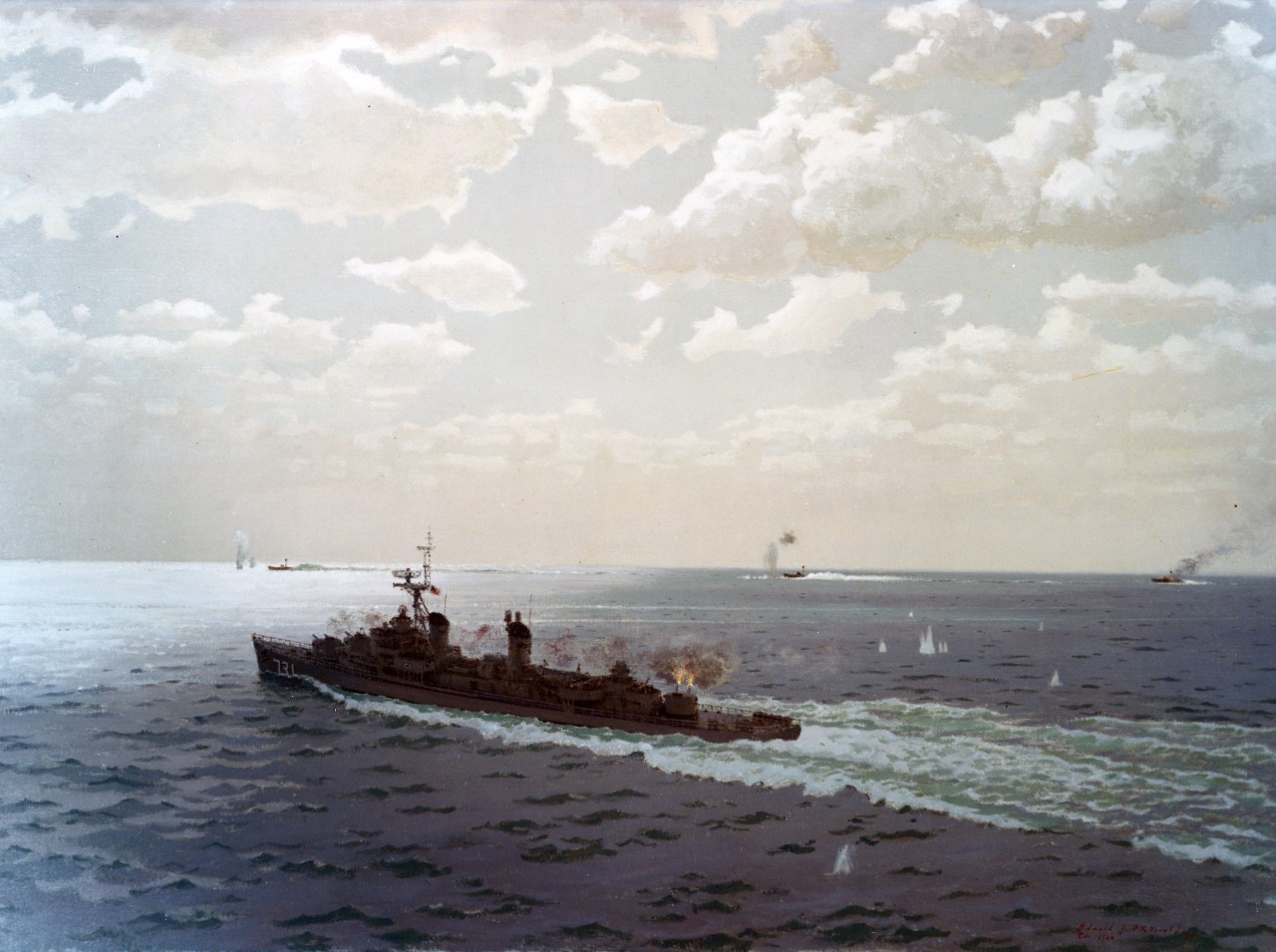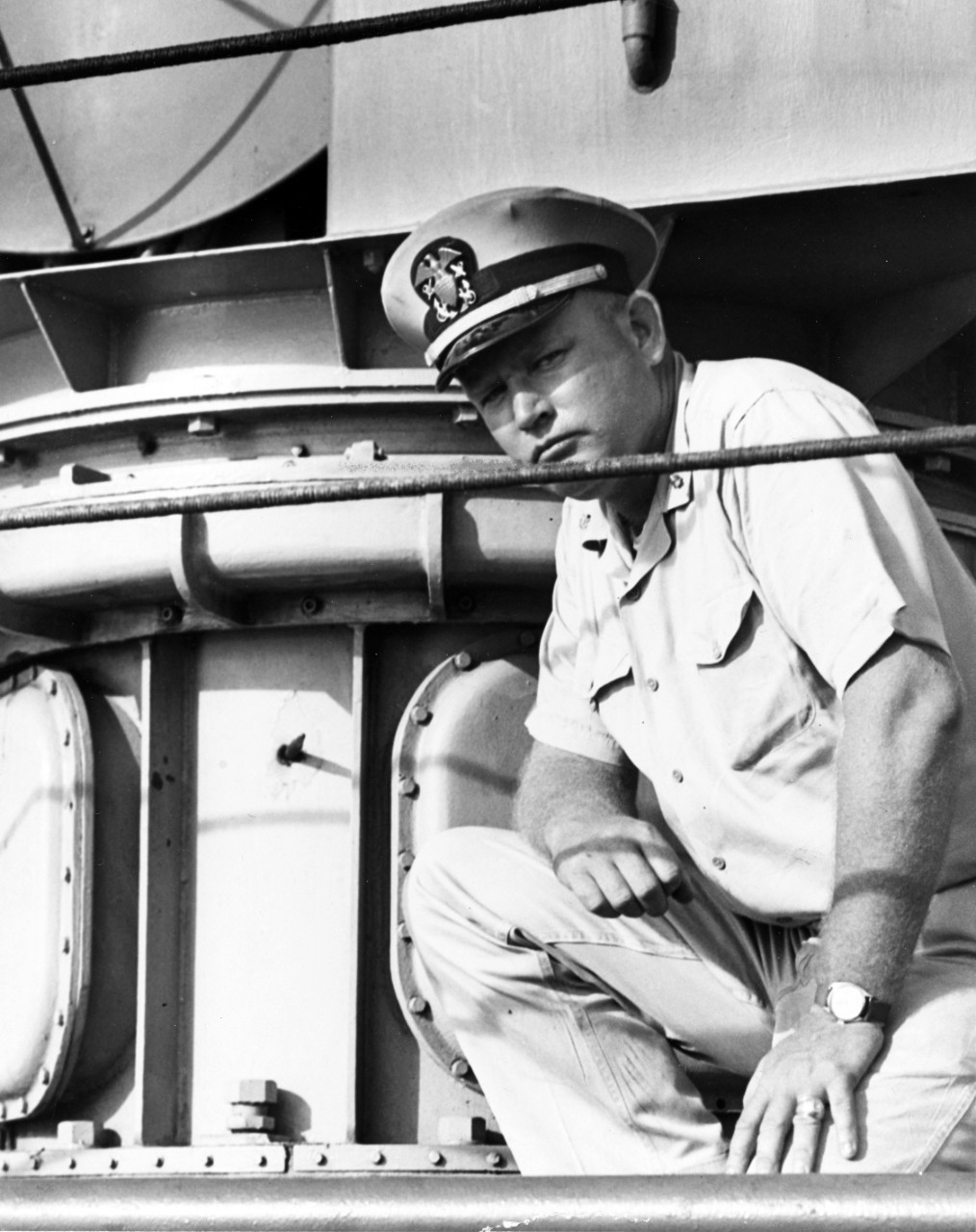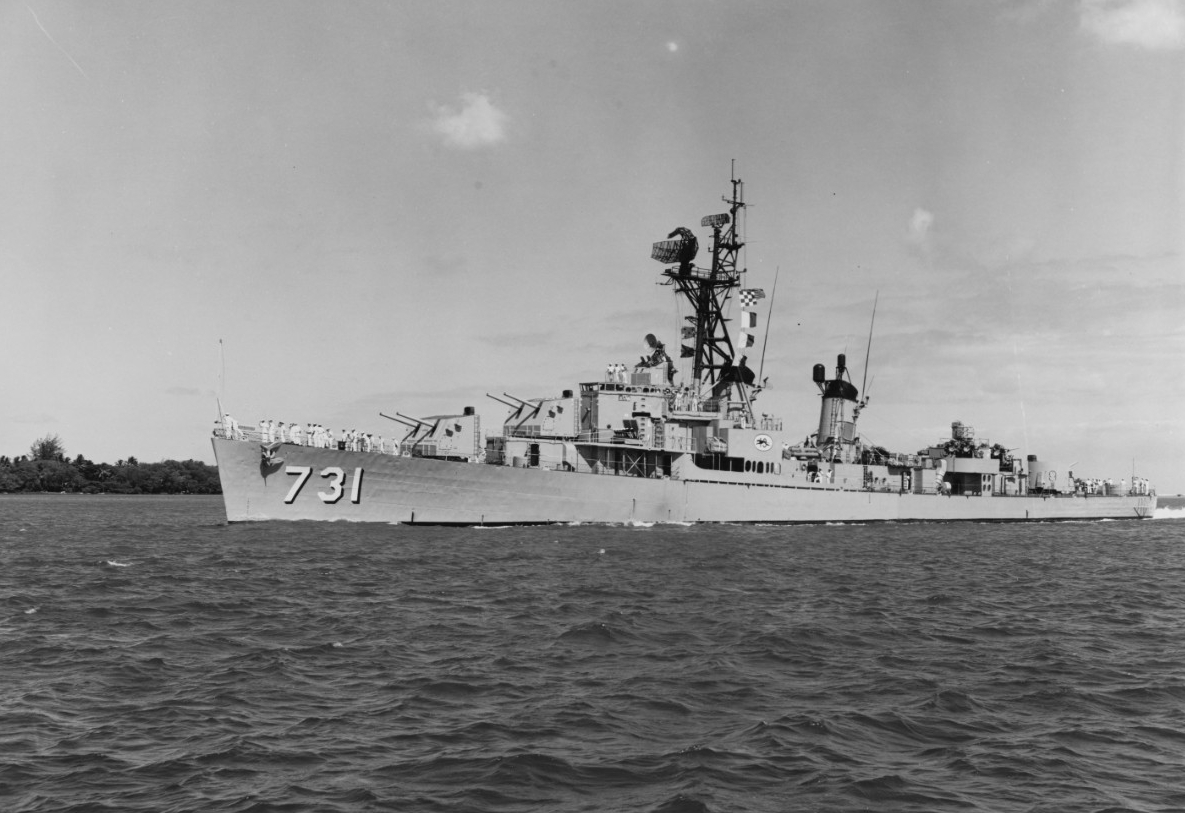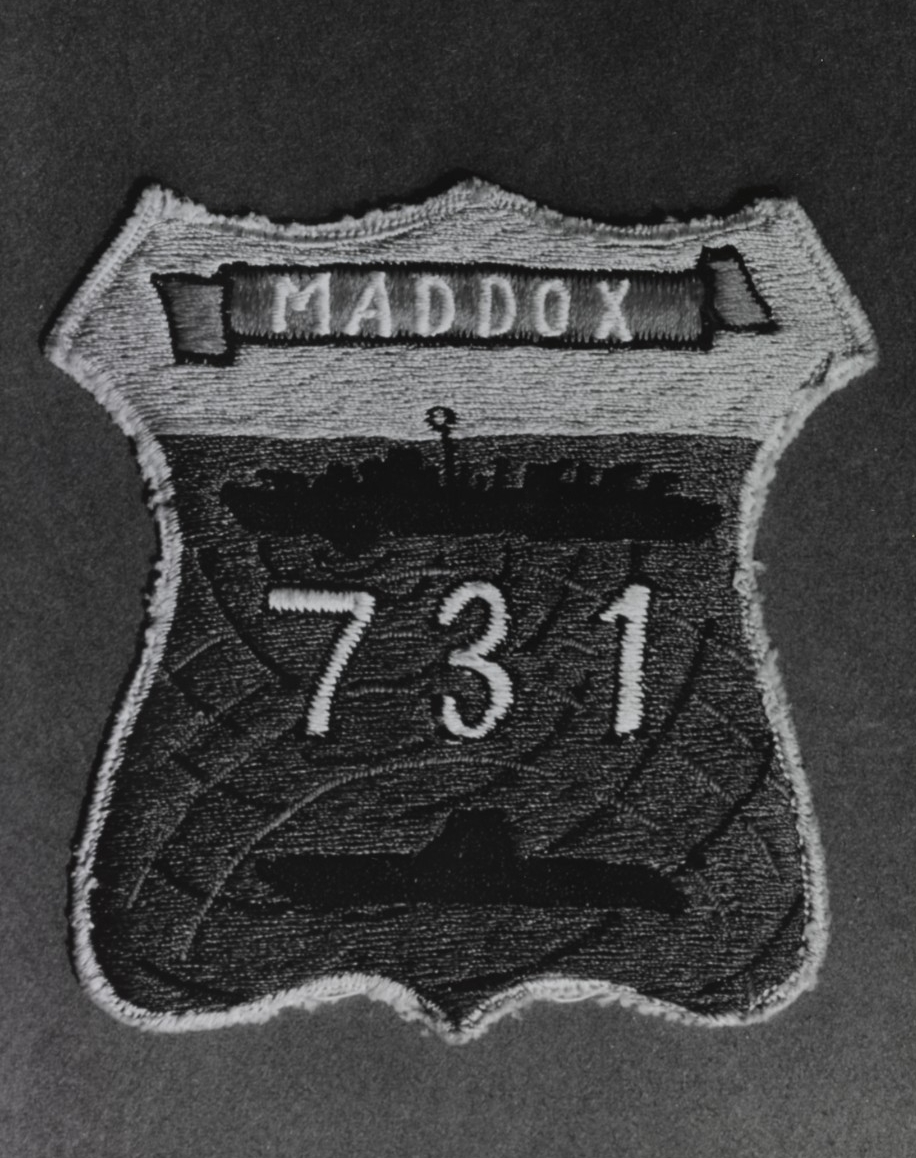USS Maddox (DD‑731)
Allen M. Sumner-class destroyer USS Maddox (DD-731) was commissioned on 2 June 1944 with Commander James S. Willis in command. After shakedown off the U.S. East Coast, Maddox steamed for the Pacific, arriving at Ulithi (a tiny atoll in the western Pacific’s Caroline Islands) on 21 October. Upon arrival, the ship was assigned to Third Fleet’s Fast Carrier Task Group 38.1. As part of the task group, Maddox participated in preparation and coverage operations for the Mindoro and Luzon invasions in the Philippines. In addition, Maddox served in the southeast China Sea while carrier-based aircraft struck targets from Saigon to Formosa. On 21 January 1945, Maddox was struck by an enemy kamikaze aircraft that required the ship to head back to Ulithi for repairs. In March, the destroyer steamed off Japan where it served on picket station during airstrikes on Kyushu and southern Honshu. Later that month, the ship proceeded to Okinawa where it provided support for pre-invasion strikes. For the duration of the campaign, Maddox provided support in the form of shore bombardment and carrier screenings for the pivotal Battle of Okinawa. On 8 July, Maddox steamed to the waters off the islands of Honshu and Hokkaido where the ship provided screening, picket, and shore bombardment services for Third Fleet operations. Maddox remained off the Japanese islands until the enemy surrendered, ending World War II.
After the war, Maddox operated off San Diego, California, until February 1946, when it returned to Far East waters to support the movement of naval occupation forces between Shanghai, Tsingtao, and Taku in China, and the ports of Pusan and Jinsen in Korea. Maddox returned to San Diego the next month and operated off the U.S. West Coast for the next three years.
On 25 June 1950, the North Korean army invaded South Korea, beginning the Korean War. Maddox was already in Far East waters, arriving in Hong Kong the day before hostilities began. On 26 June, Maddox was en route to South Korea, where during the voyage, the ship acted as an aircraft guard and antisubmarine screen for aircraft carriers USS Valley Forge (CV-45) and HMS Triumph. Maddox operated off Korean waters for about a month before the ship departed the area to help form the initial Formosa (later Taiwan) Patrol Force to prevent a Communist Chinese invasion of the island. Maddox returned to Korea on 7 September and assumed coastal blockade and bombardment duties. It continued in that role, which included a diversionary bombardment of Samchok in conjunction with Operation Chromite (Inchon landings), before Maddox made way back to San Diego in January 1951. The ship remained at the southern California city for about 11 months where it underwent an extensive overhaul.
On 1 December, Maddox departed San Diego for the ship’s second Korean deployment. Through February 1952, it screened aircraft carriers and provided bombardment support for United Nations land forces. In March, Maddox left the war zone temporarily to support the Taiwan Patrol Force before returning to Korean waters the following month. For the remainder of the tour, Maddox continued to provide screening duties for carriers and participated in the siege of Wonsan. The ship returned to San Diego in June and stayed for about a month before steaming up the coast to Long Beach, California, Maddox’s new homeport.
After local operations and overhaul, Maddox once again steamed to Korean waters in February 1953 for the ship’s third deployment to the region. As on its previous deployments, Maddox guarded aircraft carriers, provided shore bombardments, and supported the Taiwan Patrol Force. The ship completed the deployment in August and arrived back at Long Beach at the end of the month. Although an armistice was signed in July 1953 that ceased fighting on the Korean Peninsula, Maddox continued to be a presence for years in Asian waters. In December 1954, it participated in antisubmarine warfare tactics and attack carrier exercises off Kyushu, Korea, and Luzon as well as operating with the Taiwan Patrol Force. From June 1955 through May 1962, Maddox completed six cruises to the Far East, which included combined defense exercises with the forces of other Southeast Asia Treaty Organization (SEATO) nations and training operations with South Korean, Nationalist Chinese, and Japanese Self‑Defense forces.
On 13 March 1964, after operating off the U.S. West Coast for about two years, Maddox departed Long Beach for a cruise with Seventh Fleet. At the beginning of the deployment, the ship steamed with fast carrier groups in the Sea of Japan and the East China Sea, before it headed south and established a patrol off the coast of South Vietnam, arriving in late May. On 31 July, Maddox began the first leg of a patrol in the Tonkin Gulf. Initially, the patrol was routine; however, it later would prove to have global repercussions. On 2 August, while cruising in international waters, three North Vietnamese motor torpedo boats attacked Maddox. During the engagement in which torpedoes were launched at Maddox, the American destroyer put two of the boats out of action with direct hits. No American crewmembers were killed or injured during the attack, and the ship did not sustain serious damage. At first, the North Vietnamese attack was assumed to be in error, but within 48 hours, it was proven to be deliberate.
On the stormy night of 4 August, North Vietnamese patrol boats again launched an attack on Maddox, but this time the ship was accompanied by destroyer USS Turner Joy (DD-951). With fresh intelligence on North Vietnamese intent, crews on the American ships were more prepared for an attack. Early detection of their presence and skillful evasion permitted the destroyers to break contact with the first wave of attacks. However, little over an hour later, enemy torpedo boats closed in again, launching torpedoes. Maddox began firing starshells for illumination while Turner Joy opened fire on the attacking boats. USS Ticonderoga (CV-14) provided requested naval aviation support. The fighting continued for the next two-and-a-half hours before the North Vietnamese broke contact. None of the American ships were damaged during the engagements. Within a few hours, retaliation in the form of airstrikes on North Vietnamese patrol boat bases and their supporting oil storage depots commenced. The Gulf of Tonkin incident permitted President Lyndon B. Johnson and Secretary of Defense Robert McNamara, via the Tonkin Resolution, to greatly escalate U.S. military involvement in Vietnam.
After the incident, Maddox resumed carrier operations until departing for Long Beach on 17 September. After arriving back at homeport, the ship remained in a leave and upkeep status until mid-January 1965. After conducting a series of training exercises and repairs in preparation for the ship’s next western Pacific deployment, Maddox departed Long Beach on 10 July, and in early August, commenced operating with fast carriers in the Gulf of Tonkin. For the next four months, Maddox provided gunfire support off the coast of South Vietnam with aircraft carriers in their area of operations. By the end of November, the ship steamed for Long Beach, arriving on 16 December.
In the summer of 1966, Maddox steamed to Pearl Harbor on a training cruise for midshipmen. After returning to Long Beach, the ship deployed once again with Seventh Fleet making port calls at Pearl Harbor, Midway, Guam, and Taiwan. After the stops, Maddox visited Singapore and crossed the line, reaching the equator on 8 February 1967. The ship departed Subic Bay in the Philippines for home by way of Australia, New Zealand, and Pearl Harbor. The ship arrived back at Long Beach on 7 June. Maddox made two more short deployments to the western Pacific in 1968 where it conducted a variety of routine missions. Maddox was decommissioned in early 1969.
Maddox received four battle stars for the ship’s World War II service, six for the Korean War, and a Navy Unit Commendation for the Gulf of Tonkin incident.
*****
Suggested Reading
- Tonkin Gulf Crisis
- Cable Regarding the Attack on USS Maddox in the Gulf of Tonkin
- USS Maddox (DD-731) Reports, 2 August 1964
- USS Maddox (DD-731) Report of Tonkin Gulf Action, 4 August 1964
- Skunks, Bogies, Silent Hounds, and the Flying Fish: The Gulf of Tonkin Mystery, 2–4 August 1964
- Surface Navy
Interviews with USS Maddox (DD-731) Crewmembers
Video (footage recreates the ships involved in the Tonkin Gulf incident, August 1964)
- Simulated Tonkin Gulf Incident (Part 1)
- Simulated Tonkin Gulf Incident (Part 2)
- Simulated Tonkin Gulf Incident (Part 3)
- Simulated Tonkin Gulf Incident (Part 4)
- Simulated Tonkin Gulf Incident (Part 5)
- Simulated Tonkin Gulf Incident (Part 6)
- Simulated Tonkin Gulf Incident (Part 7)
- Simulated Tonkin Gulf Incident (Part 8)
Selected Imagery
Captain John J. Herrick, commander of Destroyer Division 192 (left), and Commander Herbert L. Ogier, commanding officer of USS Maddox (DD-731), on board Maddox (DD-731), 13 August 1964. They were in charge of the ship during the engagement with three North Vietnamese motor torpedo boats, 2 August 1964.

